Devices Placed In Pentland Firth to Take Measurements
22nd February 2013
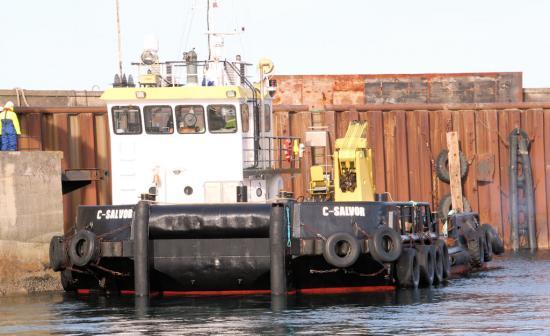
Report by Bill Mowat
The vessel was there for Mojo Maritime Ltd of Falmouth, Cornwall and was in port to deploy three 'Acoustic Doppler Current Profiler' (ADCP) devices on the seabed of the Pentland Firth's Inner Sound.
This was undertaken for MeyGen Ltd, the company that holds the Crown Estate's seabed licence for that part of the Firth as a site for development as 'the world's first commercial tidal stream electricity power station'. It hopes to install almost 400 generating turbines, with a capacity rated at 1 MW (megawatt) each there, by 2020.
All of the lease site lies within 1.5 miles of mainland Scotland's most Northerly port.
Each ADCP device measures the velocity (speed) of the tidal streams throughout the 30 metre deep water column and logs their precise direction at every stage of the twice-daily tide cycle and of the fortnighly 'springs and neaps' sequence. It also measures wave heights and directions. The devices are powered by lithium-ion batteries and will be recovered from the seabed after 4 weeks of immersion, allowing the data collected to be analysed.
Graham Stewart, project manager with Mojo Maritime, a native of Eday, Orkney, proferred thanks to all concerned at Gills Harbour who had made the ADCPs installation go so successfully in fine weather.
Mojo Maritime, which specialises in marine operations management and has a consultancy 'arm', has devised a catamaran 'High Flow Installation Vessel' (HFIV) which it is bidding to utlise firstly in the Inner Sound for MeyGen Ltd.
Information gleaned from the ADCPs will provide algorithms for use .in the software precisely controlling her 'Voith-Schneider' DP (dynamic positioning) on-board system to match the exact conditions of the Inner Sound's tides and waves.
The vessel's design is almost complete and it enabled Mojo Maritime to win the 'Oscar' for technological innovation at the International Tidal Summit three months ago, in an open competition independently judged by industry 'peer reviewers'.
It claims that Mojo Maritime HFIV will be able to install (and later retrieve as necessary) the turbines at all stages of the tidal cycle, not just at periods of 'slack water' (i.e. on the tide-turn), as with existing much larger ships built for deep-water offshore oil and gas tasks.
The company, in partnership with Bauer AG of Germany, has also devised a flexible umbilicial-linked, on board bridge-controlled drilling system designed to complete 2 metre diameter bore-holes to a depth of 10 metres into the Caithness flagstone bedrock of the Sound, as 'bases' for cylindrical steel 'mono-piles'. An adapation to the rock-drilling device can affix the monopiles to the seabed and grout them securely into position.
About 8 metres of the mono-pile will project upwards from the seabed allowing the 'jacket' section holding the generating turbines to be firmly slotted into position.
Mojo Maritime's majority shareholder and MD is Captain Richard Parkinson, who formerly was a Merchant Navy master with experience in transiting the Pentland firth in winter conditions. The company hopes to base its multi-million pound HFIV at Gills Harbour as the tidal stream generating turbines installation gathers pace later in this decade.
PHOTO
Multi-cat C-Salvor, owned by Leask Marine Ltd of Kirkwall taken at Gills Harbour.
Related Businesses
Related Articles
Three Cats At Gills Harbour
Two catamaran work-boats berthed at Gills Harbour this week with the trans-Pentlnd ferry MV Alfred, also a catamaran, in the background. The larger workboat is MPC Athenia which was being used as a floating base or ROVs - remote underwater vessels, for detailed inspections on the three turbines operating at the MeyGen demonstration subsea site one and a half miles off Gills Harbour.
GILLS HARBOUR Ltd ANNUAL GENERAL MEETING
GILLS HARBOUR Ltd - ANNUAL GENERAL MEETING at JOHN O'GROATS VILLAGE HALL, MONDAY JUNE 13th @ 7.30 PM. GILLS HARBOUR IS THE ONLY OFFICIALLY-RECOGNISED 'ECONOMIC DEVELOPMENT AREA' IN NE CAITHNESS.Latest Boats At Gills Harbour For Work At Meygen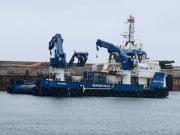
£10 million 'Isle of Jura' temporarily based at Gills Harbour in Far North of Scotland for her crew's debut tasks in the tidal-stream electricity field at the MeyGen sub-sea site, one mile off the little Caithness's port entrance channel. One of the UK's most modern marine renewables service vessels made her debut calls at community-owned Gills Harbour, near John O'Groats, over the 2021 Spring Equinoctial weekend.
Busy Gills Harbour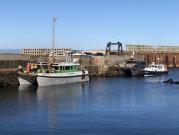
Its been a busy few days at local community-owned Gills Harbour ..... sometimes in suberb sunny weather as here ...
Energy Developments Continue at Gills Harbour and the Pentland Firth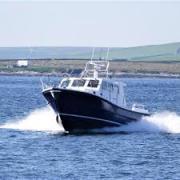
The company behind the world-leading tidal-stream prototype power plant in the Pentland Firth's Inner Sound is set to start manufacturing a new-style turbine that is hopes will reduce the project's generating costs. Simec Atlantis Energy (SAE) and a privately-owned specialist engineering firm from Spain's Bay of Biscay coastline have jointly been conducting 'research and development' (R& D) on the project for almost a year and are now ready to give it the go-ahead.
New Generation of office-bearers set to step up at Gills Harbour Ltd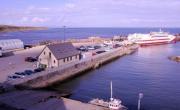
A new generation of younger local folk look set to take over the reins of running Gills Harbour Ltd, the local company that owns and operates the busy little port on the shores of the Pentland Firth's Inner Sound that holds its AGM this Saturday (10.10.20) morning at 10:00 am. The influx of younger blood comes after two key directors of the group that had run 'Canisbay's Peoples Port' both announced their retirement from office, whilst another Gills Harbour Ltd (GHL) office-bearer has declined to seek re-election.
MV Alfred And MV Pentalina Together At Gills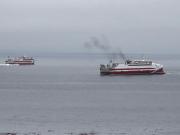
An 'old friend' returns to Gills Bay after an absence of manymonths. The 2,400 tonne 70 m.
Normand Cutter, The Norwegian-owned Offshore Construction Vessel at Gills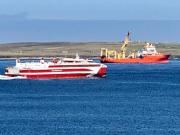
Here is the Normand Cutter, the Norwegian-owned offshore construction vessel that has been the base for works on Simec Atlantis Energy's (SAE's) MeyGen site in the Pentland Firth's Inner Sound, off Gills Bay during the current neap-tide sequence, that has lasted most of the week commencing 11.08.20. Picture by retired C of S Kirk Minister the Rev Lyall Rennie, who lives at Lower Warse, Canisbay, on the shores of Gills Bay..
New Ferry For Pentland Ferries Arrives Safely
Scotland's most modern + environmentally-friendly, fuel-efficient ROPAX ferry ship rge MV Alfred, arrived AM today (Wed 09.10.19 at St Margarets Hope. The boat went round to Kirkwall immediately at the end of 9,000+ miles voyage from the Strategic Marine yard near Ho Chi Minh city (ex.
Gills Harbour Ltd Awards Contract To Local Firm
Gills Harbour Ltd, the community-owned body that owns & operates the busy little port on Caithness's North Coast, has awarded a remedial contract to a Wick-based company. The deal, won in a competitive tender, has gone to builders/civil engineers Messrs GMR Henderson Ltd, of Martha Terrace in Wick.
